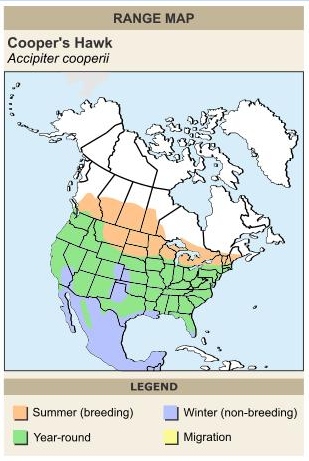|

Medium,
agile hawk with dark blue-gray back and white underparts with many fine
rufous bars. Cap is darker than upperparts. Eyes are red. The tail is
long with thick black-and-white bands. Legs and feet are yellow. Alternates
rapid wing beats and short glides,
often soars on thermals.

|
COOPER'S
HAWK
Accipiter cooperii
FALCONIFORMES
Kites, Eagles and Hawks (Accipitridae)
The Cooper’s Hawk was first described in 1828 by Charles Bonaparte,
a French naturalist and ornithologist who was the nephew of Napoleon.
It was named after William Cooper, who collected the first specimen.
SOUND: "kac-kac-kac", "kuck, kuck kuck, kuck"
It captures a bird with its feet, and will squeeze it repeatedly to
kill it, instead of biting the prey to kill it in the fashion of falcons.
It has also been known to drown its prey.
They capture prey from cover or while flying quickly through dense vegetation.
This can be dangerous, a recent study found that 23 percent had healed
fractures in the bones of the chest, especially of the furcula or wishbone.
A group of hawks has many collective nouns, including a "boil",
"knot", "spiraling", "stream", and "tower"
of hawks.
the Cooper's Hawk has a very large range, estimated globally at 8,400,000
kilometers. It is native to North America, Belize, Colombia, Costa Rica,
Honduras, Nicaragua, and Guatemala and has been spotted in Bermuda.
This bird prefers forest and shrubland areas and can also reside in
urban areas or rural gardens. It has an estimated population of between
100,000 and 1,000,000 individuals. Because there are no signs of significant
population decline, this bird does not qualify for inclusion on the
IUCN Red List. Cooper's Hawk currently has an evaluation level of Least
Concern.
|